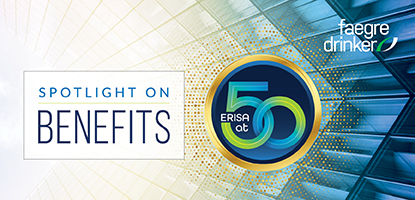On April 19, 2021, in Wilson v. Craver, No. 18-56139, 2021 WL 1523253 (9th Cir. Apr. 19, 2021), the U.S. Court of Appeals for the Ninth Circuit affirmed the dismissal of an ERISA stock-drop lawsuit brought against fiduciaries of Edison International’s employee stock ownership plan (ESOP), holding that the plaintiff failed to meet the “more harm than good” pleading standard set forth in Fifth Third Bancorp v. Dudenhoeffer, 573 U.S. 409, 428 (2014).
Month: April 2021
Department of Labor Guidance Addresses Cybersecurity Risk Mitigation
On April 14, 2021, the Department of Labor (“DOL”) issued three documents that provide cybersecurity guidance for plan sponsors, fiduciaries, recordkeepers, and plan participants. Cybersecurity has become an increasingly important topic for plan sponsors and committees, given the fiduciary requirements to act in the interest of plan participants and to prudently select and monitor service providers, in addition to general risk management considerations. While the guidance was not issued under a formal notice and comment process, it lists actions the DOL recommends that plan fiduciaries and committees take to safeguard data and monitor service providers – and potentially indicates the steps that the DOL would view as the minimum necessary to satisfy applicable fiduciary obligations.
Continue reading “Department of Labor Guidance Addresses Cybersecurity Risk Mitigation”
ERISA Litigation Roundup: Forum Selection Clause in Plan Recognized as Valid
A Ninth Circuit panel in In re Becker has held that the district court properly enforced a forum selection clause in an ERISA-sponsored 401(k) plan in litigation on alleged improper plan management.
For the full alert, visit the Faegre Drinker website.
DOL Issues Model COBRA Subsidy Notices and Initial Guidance on COBRA Subsidy Relief under the American Rescue Plan Act of 2021
As discussed in our prior blog post, the American Rescue Plan Act of 2021 (ARP) requires employers that sponsor group health plans to provide a 100% COBRA subsidy for “Assistance Eligible Individuals” during the “Subsidy Period” (April 1 through September 30, 2021, or the date the participant is no longer an Assistance Eligible Individual, if earlier) and to offer a COBRA special election opportunity for certain individuals to enroll in COBRA coverage in order to receive the benefit of the COBRA subsidy.
ERISA Litigation Roundup: Another Court Finds 401(k) Plan Participant Data Is Not a Plan Asset
The Southern District of Texas is the latest court to reject breach of fiduciary duty claims based on a party’s use of participant data.
For the full alert, visit the Faegre Drinker website.
Upcoming Webinar | Checking the Lost & Found for Missing Participants: What Plan Sponsors Need to Be Doing!
In response to ongoing requests by plan sponsors, service providers and industry associations alike, the Department of Labor (DOL) issued informal, legally nonbinding guidance earlier this year to help address issues surrounding missing retirement plan participants. Join members of Faegre Drinker’s benefits and executive compensation group on April 14 from 11:00 – Noon CT, as we explore best practices for plan sponsors to identify missing and nonresponsive plan participants, as well as potential approaches to facilitate compliance and mitigate risk of penalties.
Departments Release FAQs on Implementing the Mental Health and Substance Use Disorder Parity Requirements under the Consolidated Appropriations Act
As described in a recent blog post, the Consolidated Appropriations Act, 2021 amended the Mental Health Parity and Addiction Equity Act (MHPAEA) to require group health plans and health insurance issuers (collectively, “group health plans”) that impose non-quantitative treatment limitations (NQTLs) on mental health or substance use disorder (MH/SUD) benefits to perform and document comparative analyses, in order to demonstrate that such NQTLs comply with the requirements of the MHPAEA1. This requirement became effective on February 10, 2021, along with the requirement that a group health plan must provide the comparative analyses to the Department of Labor (DOL), Health and Human Services (HHS), or applicable State authority upon request.
The Consolidated Appropriations Act also directed the DOL, HHS, and the Treasury (together, the “Departments”) to issue additional guidance for group health plans, intended to clarify and provide examples of methods group health plans may implement to comply with the comparative analyses and disclosure obligations.
More Employees Will Be 162(m) Covered Employees under the American Rescue Plan Act
The American Rescue Plan Act (ARPA), passed by Congress and signed into law on March 11, 2021, expands the definition of “covered employee” under Internal Revenue Code Section 162(m), requiring the inclusion of an additional top five highest paid employees (beyond those officers already counted).
Section 162(m) imposes a $1 million deduction limit on remuneration paid to a covered employee. Currently, covered employees for a particular tax year include the principal executive officer, the principal financial officer, and the next three most highly compensated officers (the Five Officers). The 2017 Tax Cuts and Jobs Act (TCJA) changed the Section 162(m) rules for tax years after December 31, 2016, so that an individual’s status as a covered employee will continue even if he or she is no longer among the five highest paid officers (e.g., for purposes of compensation paid after he or she terminates from employment with the public company). Therefore, today the list of covered employees includes the Five Officers and anyone who was one of the Five Officers for tax years beginning after December 31, 2016.

